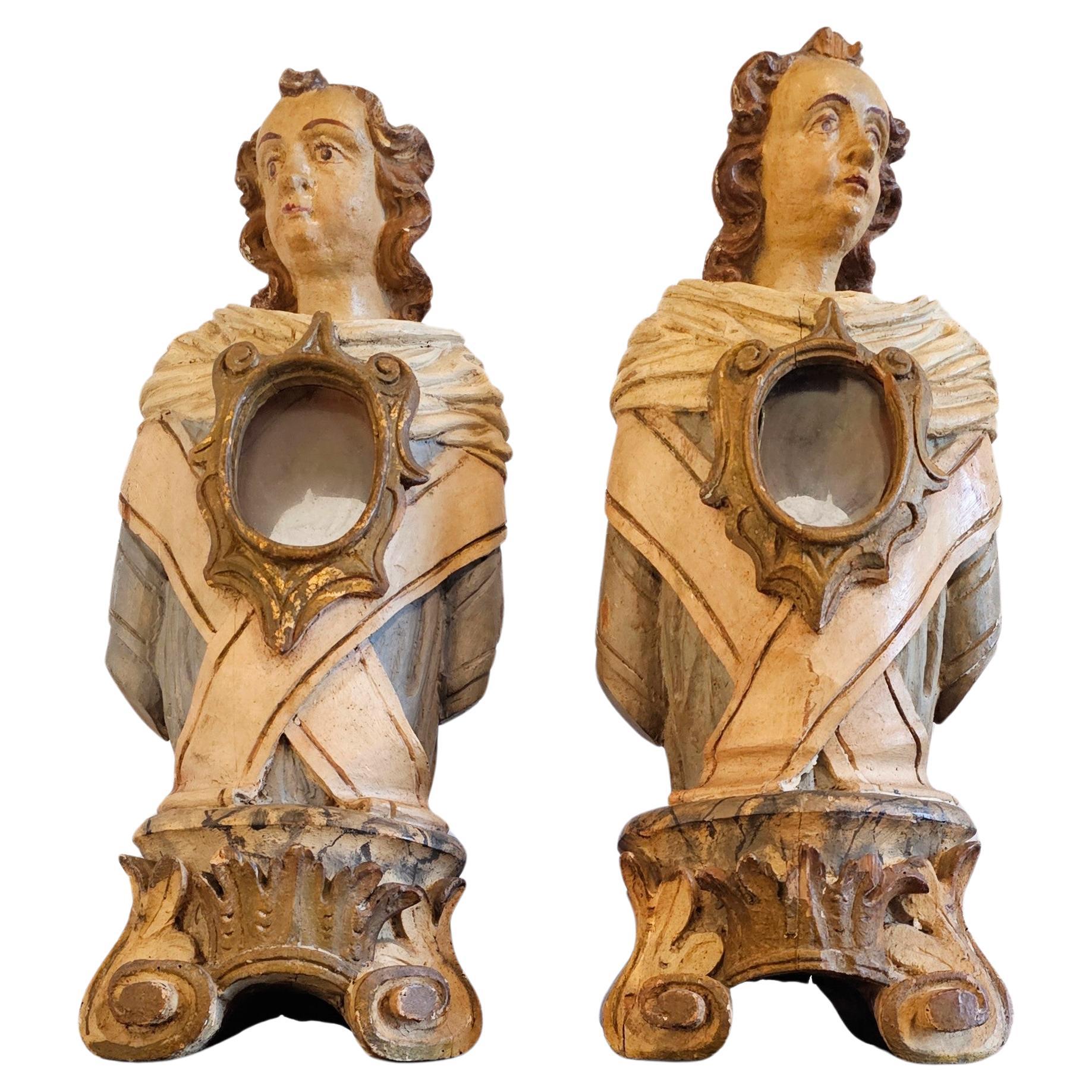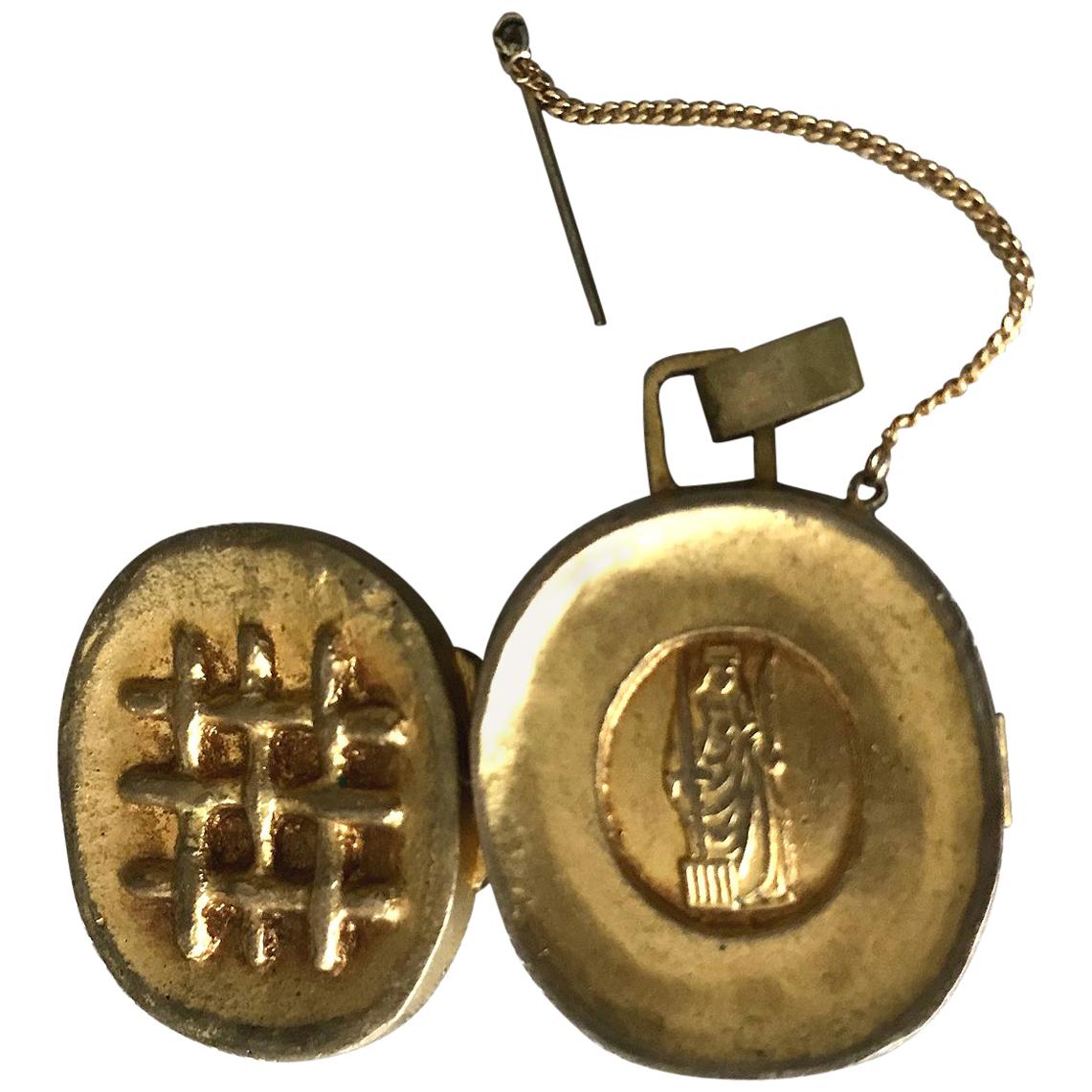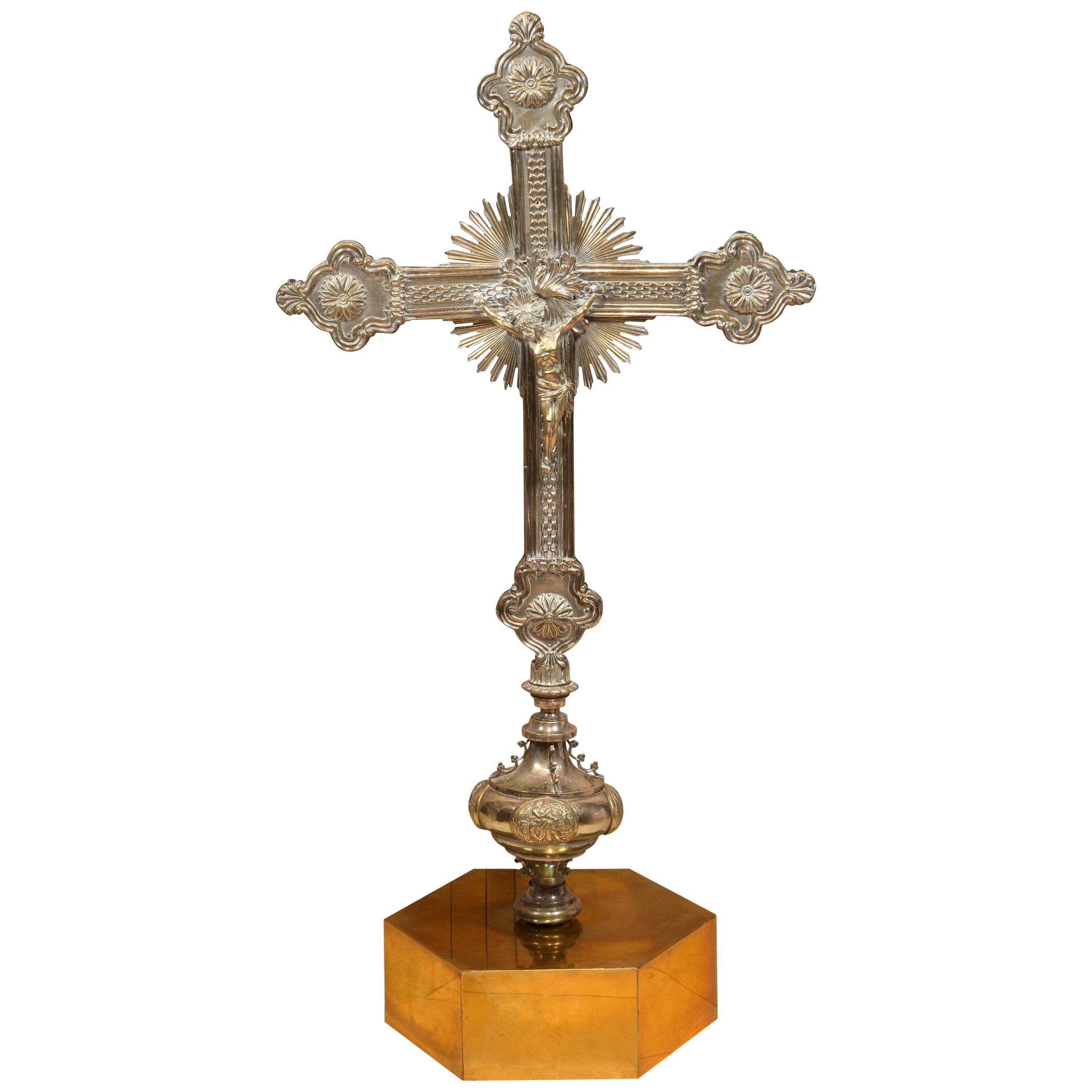Items Similar to Ebony Wood and Gilt Bronze Reliquary Altar Cross After Giambologna
Want more images or videos?
Request additional images or videos from the seller
1 of 11
Ebony Wood and Gilt Bronze Reliquary Altar Cross After Giambologna
About the Item
Anonymous (corpus after a model by Giambologna)
circa 1700; Netherlandish or Northern Rhinish
Ebonized wood, gilt bronze appliques and statuettes, textiles and relics
Approximate size: 75 cm (h)
The present altar cross features a gilt bronze crucifix cast after a model by Giambologna, originally executed ca. 1579-89. In particular, the present figure of Christ follows examples finished by Giambologna’s assistant, Antonio Susini, like one example made for the altar of the Salviati Chapel in San Marco—Florence, Italy. However, the free reinterpretation of Christ’s hair and face could alternatively suggest the hand or influence of Taddeo Curradi, another friend and collaborator of Giambologna and Susini.
The present crucifix was likely cast later than the model’s invention, in the Netherlands or Northern Germany. It was not uncommon for Italian models to travel North of the Alps, and in particular, Giambologna’s assistant, Adriaen de Vries, was one such channel for the diffusion of such models into those territories.
The ebony wood construction of the present altar cross is tantamount to the talents of Flemish woodworkers of the period and another architecturally related example, also featuring a crucifix cast after Giambologna’s model, is found in the treasury of Cologne Cathedral (inv. RBA 135 379).
The figure of Christ and its accompanying skull, representing Golgotha, are probably earlier than the other bronzes present on the altar cross, cast probably during the 17th century, while the titulus, central applique nested in a niche and the flanking free-standing figures of St. John and Mary, in-the-round, are later inventions, perhaps of the early 18th century.
As with other objects-of-devotion, this distinctive altar may have been updated and reinterpreted over the duration of its history. In this case, the bronze crucifix has received a new context on the present altar. Some veneers may be later replacements and the relics may replace what could have originally been granite insets, replaced in the 18th century by relics backed by velvet. Some features of the woodwork could be later, like the base, stepped tier, and socle for the cross.
Condition: Rubbing on bronzes, commensurate with their age. Loss to a finger on the proper right arm of Christ and the perizonium along the hip. Finial appliques once flanked the ends of the crucifix, now lost. Velvet backing for the relics is possibly original (introduced during the 18th century) but shows signs of wear commensurate with age. The cross is slightly crooked due wear and exposure to various climate conditions over time. There are various dings, scratches and losses to the plinth, typical to works of this age and use. Overall, in fair condition and still retaining the essence of its former glory.
- Dimensions:Height: 25.5 in (64.77 cm)Width: 11.25 in (28.58 cm)Depth: 4.75 in (12.07 cm)
- Style:Baroque (Of the Period)
- Materials and Techniques:
- Place of Origin:
- Period:1690-1699
- Date of Manufacture:Unknown
- Condition:Replacements made: Some restorations or replacements over time, commensurate with age. Wear consistent with age and use.
- Seller Location:Leesburg, VA
- Reference Number:1stDibs: LU8166233261262
About the Seller
5.0
Vetted Seller
These experienced sellers undergo a comprehensive evaluation by our team of in-house experts.
Established in 2013
1stDibs seller since 2023
20 sales on 1stDibs
Typical response time: 6 hours
- ShippingRetrieving quote...Ships From: Leesburg, VA
- Return PolicyThis item cannot be returned.
More From This SellerView All
- A 17th century Roman Altar Cross after Guglielmo della PortaLocated in Leesburg, VAA 17th century Roman altar cross after Guglielmo della Porta Approximate size: 67 x 27 cm The present altar cross, likely of Italian Roman origin, reprod...Category
Antique 17th Century Italian Renaissance Religious Items
MaterialsAgate, Lapis Lazuli, Bronze
- 15th century Gilt Bronze Pax of the Virgin and Child, after DonatelloLocated in Leesburg, VAAnonymous, school of Donatello Second half of the 15th century; Northern Italy Approximate size: 13 x 7.6 cm The present relief of the Virgin and Child is largely considered derive...Category
Antique 15th Century and Earlier Italian Renaissance Religious Items
MaterialsBronze
- 15th century North Italian Gilt Bronze Pax of the LamentationLocated in Leesburg, VAAnonymous Second half of the 15th century; Northern Italy, possibly Milan Gilt bronze Approximate size: 17.2 x 13 cm The present pax probably derives from a finer original realized in more precious materials. For example, the vigor of its central motif is carved in such a way as to suggest the original artwork was conceived in carved stone or perhaps mother-of-pearl. The intricacy of its frame suggests a separate master adept in silverwork. Overall, this bronze pax...Category
Antique 15th Century and Earlier Italian Renaissance Religious Items
MaterialsBronze
- A natural striped Chambered Nautilus Half Shell displayed in a Black TabernacleLocated in Leesburg, VAA natural striped Chambered Nautilus Half Shell displayed in a Black Wooden Tabernacle Nautilus Pompulus Philippines; harvested in the 20th century The wood tabernacle, late 20th ce...Category
Late 20th Century American Baroque Nautical Objects
MaterialsShell, Wood
- Rare and important painted bronze Crucifix after a model by MichelangeloBy Michelangelo BuonarrotiLocated in Leesburg, VAA rare and very fine bronze corpus of Christ after a model by Michelangelo, cast ca. 1597-1600 by Juan Bautista Franconio and painted in 1600 by Francisco Pacheco in Seville, Spain. The present corpus reproduces a model attributed to Michelangelo. The best known example, lesser in quality, is one on display at the Metropolitan Museum of Art (MET). The association of this corpus with Michelangelo was first brought to light by Manuel Gomez-Moreno (1930-33) who studied the wider circulated casts identified throughout Spain. The attribution to Michelangelo was subsequently followed by John Goldsmith-Phillips (1937) of the MET and again by Michelangelo expert, Charles de Tolnay (1960). While Michelangelo is best known for his monumental works, there are four documented crucifixes he made. The best known example is the large-scale wooden crucifix for the Church of Santa Maria del Santo Spirito in Florence, made in 1492 as a gift for the Prior, Giovanni di Lap Bicchiellini, for allowing him to study the anatomy of corpses at the hospital there. In 1562, Michelangelo wrote two letters to his nephew, Lionardo, indicating his intention to carve a wooden crucifix for him. In 1563 a letter between Lionardo and the Italian sculptor Tiberio Calcagni, mentions this same crucifix (a sketch of a corpus on the verso of a sheet depicting Michelangelo’s designs for St. Peter’s Basillica [Palais des Beaux-Arts in Lille] may reproduce this). That Michelangelo was working on small corpora in the last years of his life is further evidenced by the small (26.5 cm) unfinished wooden crucifix located at the Casa Buonarroti, considered his last known sculptural undertaking. Michelangelo’s contemporary biographer, Giorgio Vasari additionally cites that Michelangelo, in his later years, made a small crucifix for his friend, Menighella, as a gift. Surviving sketches also indicate Michelangelo’s study of this subject throughout his career, most notably during the end of his life but also during the 1530s-40s as he deepened his spiritual roots. The occasional cameo of crucified Christ’s throughout his sketched oeuvre have made it challenging for scholars to link such sketches to any documented commissions of importance. All the while, in consideration that such objects were made as gifts, it is unlikely they should be linked with commissions. Nonetheless, a number of theories concerning Michelangelo’s sketches of Christ crucified have been proposed and some may regard the origin of the present sculpture. It has been suggested that the corpus could have its impetus with Michelangelo’s work on the Medici Chapel, whose exclusive design was given to the master. It is sensible smaller details, like an altar cross, could have fallen under his responsibility (see for example British Museum, Inv. 1859,0625.552). Others have noted the possibility of an unrealized large marble Crucifixion group which never came to fruition but whose marble blocks had been measured according to a sheet at the Casa Buonarroti. A unique suggestion is that Michelangelo could have made the crucifix for Vittoria Colonna, of whom he was exceedingly fond and with whom he exchanged gifts along with mutual spiritual proclivities. In particular, Vittoria had an interest in the life of St. Bridget, whose vision of Christ closely resembles our sculpture, most notably with Christ’s proper-left leg and foot crossed over his right, an iconography that is incredibly scarce for crucifixes. The suggestion could add sense to Benedetto Varchi’s comment that Michelangelo made a sculpted “nude Christ…he gave to the most divine Marchesa of Pescara (Vittoria Colonna).” Of that same period, two sketches can be visually linked to our sculpture. Tolnay relates it to a sketch of a Crucified Christ at the Teylers Museum (Inv. A034) of which Paul Joannides comments on its quality as suggestive of preparations for a sculptural work. Joannides also calls attention to a related drawing attributed to Raffaello da Montelupo copying what is believed to be a lost sketch by Michelangelo. Its relationship with our sculpture is apparent. Montelupo, a pupil of Michelangelo’s, returned to Rome to serve him in 1541, assisting with the continued work on the tomb of Pope Julius II, suggesting again an origin for the corpus ca. 1540. The earliest firm date that can be given to the present corpus is 1574 where it appears as a rather crudely conceived Crucifixion panel, flanked by two mourners in low-relief and integrally cast for use as the bronze tabernacle door to a ciborium now located at the Church of San Lorenzo in Padula. Etched in wax residue on the back of the door is the date, 27 January 1574, indicating the corpus would have at least been available as a model by late 1573. The Padula tabernacle was completed by Michelangelo’s assistant, Jacopo del Duca and likely has its origins with Michelangelo’s uncompleted tabernacle for the Basilica of St. Mary of the Angels in Rome. The impetus for the Padula tabernacle’s Crucifixion panel begins with a series of late Crucifixion sketches by Michelangelo, depicting a scene of Christ crucified and flanked by two mourners (see British Museum Inv. 1895.0915.510; Ashmolean Museum Inv. 1846.89, KP II 343 recto; Windsor Castle RCIN 912761 recto; and Louvre Inv. 700). A faintly traced block possibly intended for sculpting the sketch of the crucified Christ on its recto was discovered by Tolnay on a version of the composition at Windsor Castle. The Windsor sketch and those related to it appear to have served as preparatory designs for what was probably intended to become the Basilica of St. Mary’s tabernacle door. Vasari documents that the project was to be designed by Michelangelo and cast by his assistant, Jacopo del Duca. Michelangelo died before the commission was complete, though on 15 March 1565, Jacopo writes to Michelangelo’s nephew stating, “I have started making the bronze tabernacle, depending on the model of his that was in Rome, already almost half complete.” Various circumstances interrupted the completion of the tabernacle, though its concept is later revitalized by Jacopo during preparations to sell a tabernacle, after Michelangelo’s designs, to Spain for Madrid’s El Escorial almost a decade later. The El Escorial tabernacle likewise encountered problems and was aborted but Jacopo successfully sold it shortly thereafter to the Carthusians of Padula. An etched date, 30 May 1572, along the base of the Padula tabernacle indicates its framework was already cast by then. A 1573 summary of the tabernacle also describes the original format for the door and relief panels, intended to be square in dimension. However, a last minute decision to heighten them was abruptly made during Jacopo’s negotiations to sell the tabernacle to King Phillip II of Spain. Shortly thereafter the commission was aborted. Philippe Malgouyres notes that the Padula tabernacle’s final state is a mixed product of the original design intended for Spain’s El Escorial, recycling various parts that had already been cast and adding new quickly finished elements for its sale to Padula, explaining its unusually discordant quality, particularly as concerns the crudeness of the door and relief panels which were clearly made later (by January 1574). Apart from his own admission in letters to Spain, it is apparent, however, that Jacopo relied upon his deceased master’s designs while hastily realizing the Padula panels. If Michelangelo had already earlier conceived a crucifix model, and Jacopo had access to that model, its logical he could have hastily employed it for incorporation on the door panel to the tabernacle. It is worth noting some modifications he made to the model, extending Christ’s arms further up in order to fit them into the scale of the panel and further lowering his chin to his chest in order to instill physiognomic congruence. A crude panel of the Deposition also follows after Michelangelo’s late sketches and is likewise known by examples thought to be modifications by Jacopo based upon Michelangelo’s initial sculptural conception (see Malgouyres: La Deposition du Christ de Jacopo del Duca, chef-d’oeuvre posthume de Michel-Ange). Jacopo’s appropriation of an original model by Michelangelo for more than one relief on the Padula tabernacle adds further indication that the crucifix was not an object unique to Jacopo’s hand, as few scholars have posited, but rather belongs to Michelangelo’s original...Category
Antique 16th Century Renaissance Figurative Sculptures
MaterialsBronze
- Yellow Marine Sponge Mounted on an Antique SocleLocated in Leesburg, VAA yellow marine sponge fixed to an antique socle. The yellow marine sponge, or aplysina fistularis, often called the ‘yellow candle sponge,’ is here appr...Category
20th Century Italian Renaissance Nautical Objects
MaterialsOrganic Material, Wood
You May Also Like
- Reliquary Altar. Wood, Glass, Metal, Etc. Spain, 17th CenturyLocated in Madrid, ESWall reliquary altar. Carved, polychrome and gilded wood, glass, metal, etc. Spanish school, 17th century. Reliquary altar made of carved, gilded and polychrome wood composed of a part that imitates a curtain of the type usually used to cover altars and other pieces when they are not used, topped by a winged angel head, and a composition organized around a tondo large central stem, from which arise a series of stems ending in scrolls. Some of these stems (eight in total) eventually form a kind of crown of leaves in the center of which are as many circular reliquaries of saints. In this mentioned central tondo there is an Agnus Dei (or Ágnusdei) made of wax. On the visible side there is an image of the Risen Christ (inspired by the one sculpted by Michelangelo Buonarroti around 1520 and found in Santa Maria sopra Minerva in Rome) accompanied by angels with symbols of the Passion and on a pedestal. This image is known to have been used on these pieces before 1598, again in 1619, and again in 1690. These relics (they are blessed by the Pope) get their name because they are printed on the front, above the book with the seven seals , the haloed Paschal Lamb carrying the banner of the Resurrection. In the text around the image, it seems to include a reference to Pope Pius V...Category
Antique 17th Century Spanish Baroque Religious Items
MaterialsMetal, Other
- 18th Century Italian Carved Painted Wood Reliquary Altar Figure Bust PairLocated in Forney, TXA remarkable pair of scarce large Italian Baroque period carved and painted wood church altar reliquary busts. Born in Italy in the 18th century / possibly late 17th century, figural form, each hand carved from a single log, modeled as opposing figures, parcel gilt polychrome decorated, hollowed central cavity with original glazed glass relic viewing panel, rising on integral marbleized scroll foot base. Dimensions: (each) 21.25" Tall, 8.5" Wide, 8" Deep; 16.25lbs Total Condition Report: Very good original unrestored antique condition with beautifully aged patina. Wear consistent with age and use, including scattered nicks, chips, and chippy paint losses. One glazed panel with losses to sides. Overall in great shape, strong, sturdy, stable, and structurally sound. Presents splendidly We here at Lynx Hollow Antiques absolutely love decorating with religious antiques! From an antique altarpiece, tabernacle, reredos, shrine niche, baptismal font, crucifix, santo statue, icon, religious folk art, retablo, monastery table to church architectural elements...Category
Antique 18th Century Italian Baroque Religious Items
MaterialsBlown Glass, Wood
- Gilt Bronze Reliquary Pendant by Line VautrinBy Line VautrinLocated in Atlanta, GAA piece of wonderful jewelry by Line Vautrin designed in 1941 on the subject of St Foi, a child martyr on the early fourth century and the patron saint of prinsoers, in a rare form of a reliquary...Category
Vintage 1940s French Mid-Century Modern Collectible Jewelry
MaterialsBronze
- Italian Gilt Reliquary BoxLocated in Dallas, TXThis 18th century Italian gilded reliquary box is made to contain a personal relic or shine. It has brackets for wall mounting. The front of the door has...Category
Antique 18th Century Italian Religious Items
MaterialsGiltwood
- Gilded Bronze Processional Cross Top, 20th Century, after Earlier ModelsLocated in Madrid, ESEnd of processional cross. Ormolu, 20th century. Latin cross with straight arms with decoration of tongues between moldings on both fronts, rays at the intersection of the arms, an...Category
20th Century Spanish Baroque Religious Items
MaterialsBronze
- Wood, Gesso, and Silver Leaf ReliquaryLocated in Chicago, ILGesso, wood and silver leaf reliquary with window and door. Cool.Category
Antique 1820s Italian Sculptures and Carvings
MaterialsSilver Leaf





